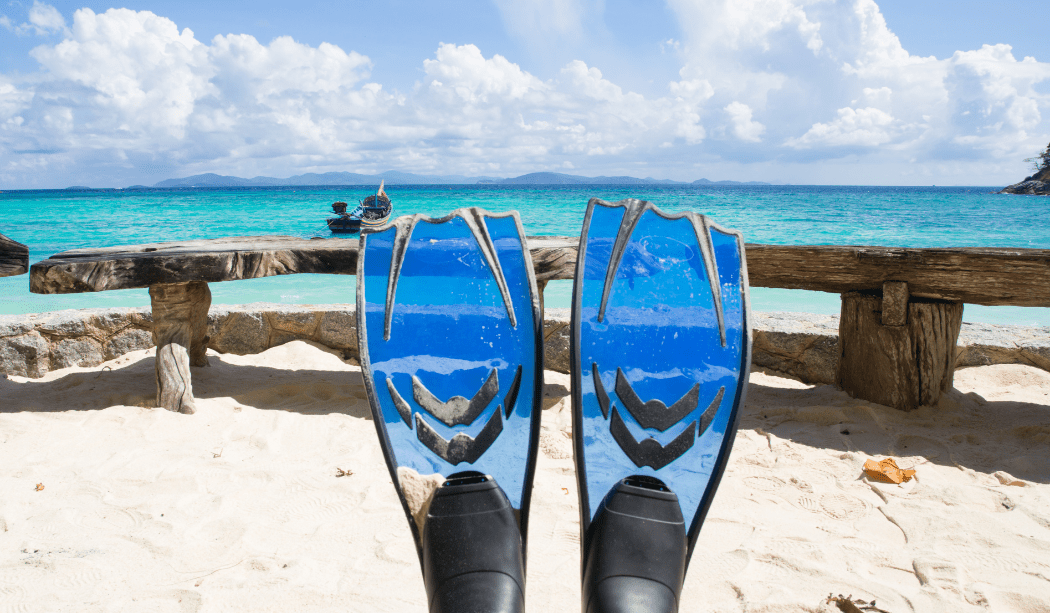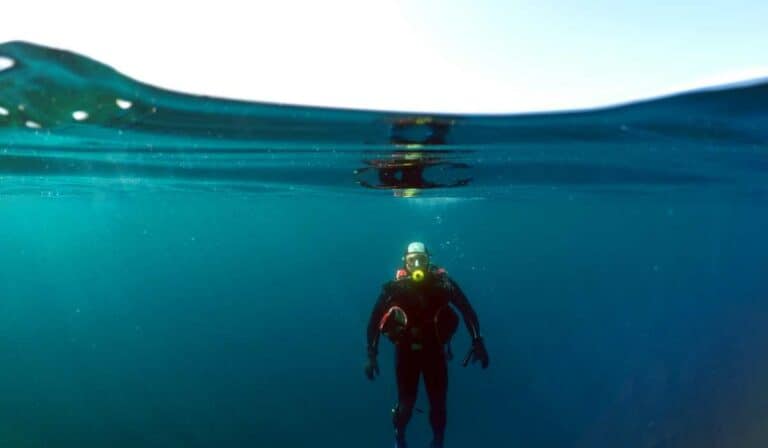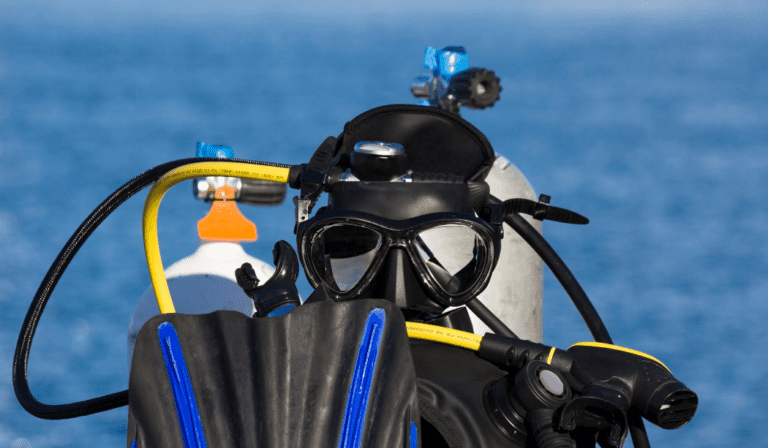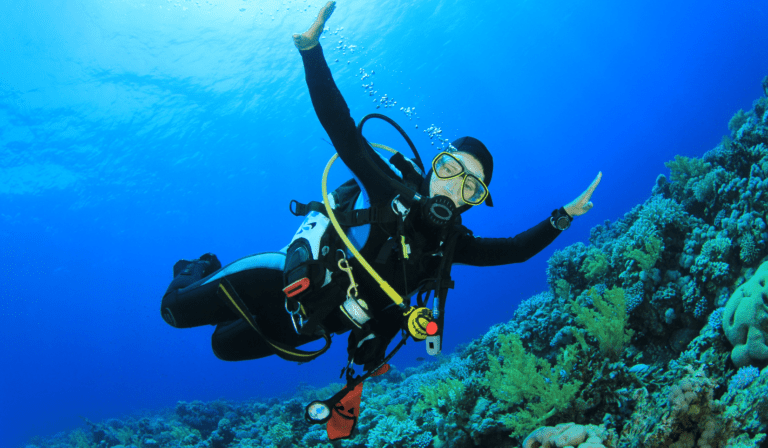Discover the Best Scuba Diving Fins of the Year
As an integral part of a diver or snorkeler’s equipment, scuba diving fins are indispensable for efficiently moving through the water.
In this comprehensive guide, we’ll explore various types of scuba diving fins, including paddle fins, split fins, force fin, free diving, and travel fins.
Table of Contents
1. Types of Scuba Diving Fins
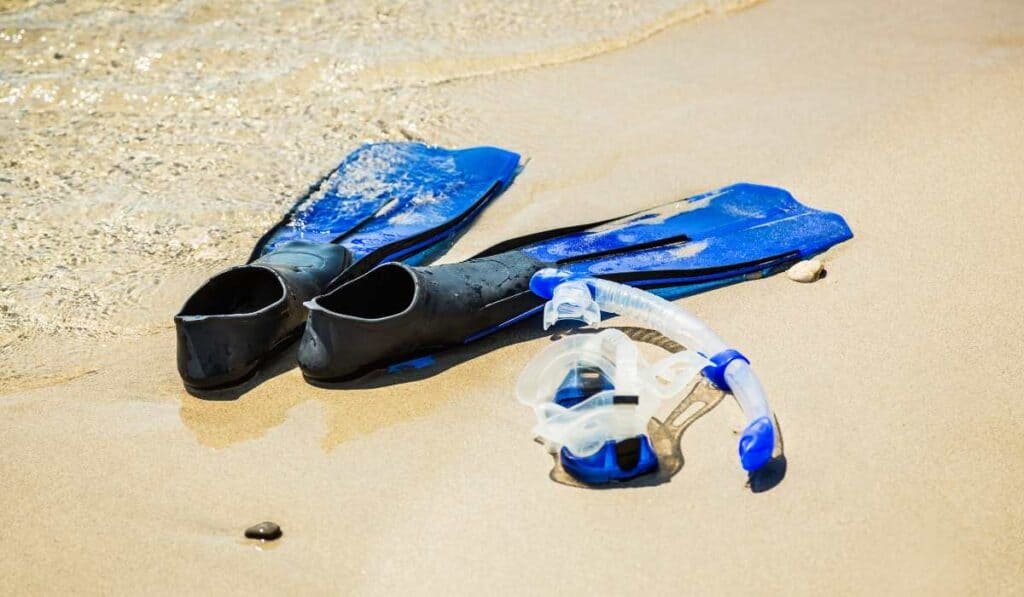
Diving into the underwater world is an exhilarating experience, and having the right scuba diving fins can make all the difference in your adventure. The market offers a variety of fins, each crafted to suit distinct diving conditions and techniques. In order to ensure you have the best experience possible, we will review different types of scuba diving fins so that you can select the perfect pair.
Paddle Fins
Paddle fins are a popular choice among divers due to their simplicity and versatility. These traditional-style fins feature a flat blade that provides propulsion by pushing water backward as you kick. Paddle fins come in varying stiffness levels; stiffer blades offer more power but require greater leg strength, while softer blades provide better maneuverability with less effort.
Split Fins
Split fins, as their name suggests, have a split down the middle of each fin blade which creates two separate panels that work together to propel you through the water efficiently with minimal effort. This design reduces drag and conserves energy during long dives or strong currents.
Force Fin Style (Vented)
The Force Fin style (vented) fins incorporate vents at the base of their paddle-shaped blades allowing water to pass through during upstroke reducing resistance and improving efficiency when kicking hard or swimming against the current.
Freediving/Spearfishing Fins
- Freediving and spearfishing fins are designed for divers who need to reach greater depths quickly. These fins have long, flexible blades that maximize propulsion with minimal effort, allowing freedivers to conserve energy and oxygen during their dives.
Travel Fins
If you’re a frequent traveler or prefer lightweight gear, travel fins are an excellent option. These compact fins typically feature shorter blades and can be easily packed in your luggage without taking up too much space.
In summary, the type of scuba fins you choose will depend on your preferred diving style, physical strength, and personal preferences. Each type has its pros and cons; understanding these differences will help you make an informed decision when purchasing your next pair of scuba diving fins from SunWaterDirt.com.
Scuba diving fins are essential pieces of equipment for any diver, providing increased propulsion and maneuverability underwater. Selecting the ideal fins for you is easy, with a broad selection of options. Exploring further, let’s delve into the advantages of having scuba diving fins in your gear.
Key Takeaway:
This section explores the different types of scuba diving fins available on the market, including paddle fins, split fins, Force Fin style (vented) fins, freediving/spearfishing fins, and travel fins. Each type has its pros and cons depending on your preferred diving style, physical strength, and personal preferences. Comprehending the distinctions between these types of fins can aid you in selecting a pair that best suits your diving style, muscular strength, and individual preferences.
Click here to read about Diving in the Lone Star State: The Best Places to Scuba Dive in Texas
2. Benefits of Scuba Diving Fins
Scuba diving fins are an essential piece of equipment for anyone looking to explore the underwater world. They provide numerous advantages and benefits that make your diving experience more enjoyable, efficient, and safe. In this section, we will discuss some of the key benefits associated with using scuba diving fins.
Improved Mobility & Speed
The fins’ extended area of surface area enables swimmers to traverse the water more expeditiously than if they were swimming sans them, necessitating less energy. The increased surface area provided by the fin blades helps propel you through the water more efficiently than if you were swimming without them.
Better Control & Maneuverability
Fins also improve control over your movements while submerged, enabling divers to navigate tight spaces or avoid obstacles with ease. This enhanced maneuverability is particularly useful when exploring caves or shipwrecks where precise movement is crucial for safety reasons.
It is easier on Your Body
- Muscle strain reduction: Using scuba diving fins reduces muscle strain on your legs as they help distribute propulsion force evenly across a larger surface area instead of concentrating it solely on specific muscles like when swimming barefoot.
- Air consumption efficiency: Efficient use of energy means that divers can conserve their air supply longer during dives since less effort is required for propulsion compared to swimming without fins.
- Joints protection: Fins also reduce stress on joints such as ankles and knees due to their design which allows smoother kicking motions under water pressure conditions.
Enhanced Safety
Scuba diving fins contribute to overall dive safety by providing divers with better control, mobility, and efficiency in the water. In case of emergencies or strong currents, having a good pair of fins can make all the difference when it comes to getting back to the surface or reaching your dive buddy quickly.
Variety of Styles for Different Dive Conditions
Different types of scuba diving fins are available to suit different preferences and needs. Whether you prefer split fins, paddle fins, or full-footed designs, there is something out there for every diver’s unique requirements based on their preferred type of diving environment.
In summary, investing in a quality pair of scuba diving fins will greatly enhance your underwater experience by improving speed, maneuverability, energy conservation, and overall safety during dives. With so many options available today at varying price points and styles tailored for specific conditions – finding the perfect set has never been easier.
Scuba diving fins are an essential part of any diver’s gear, providing increased propulsion and maneuverability underwater. As you consider which fins to buy for your next dive, it is important to understand the features that make each type unique.
Key Takeaway:
Scuba diving fins are a crucial piece of equipment that enhances mobility, control, and safety while exploring the underwater world. They reduce muscle strain, conserve air supply, protect joints, and provide better propulsion than swimming barefoot. With various styles available for different dive conditions, investing in quality scuba diving fins will make your dives more enjoyable and efficient.
Click here to read about Best Watches for Scuba Diving: Time to Dive In
3. Features to Consider When Buying Scuba Diving Fins
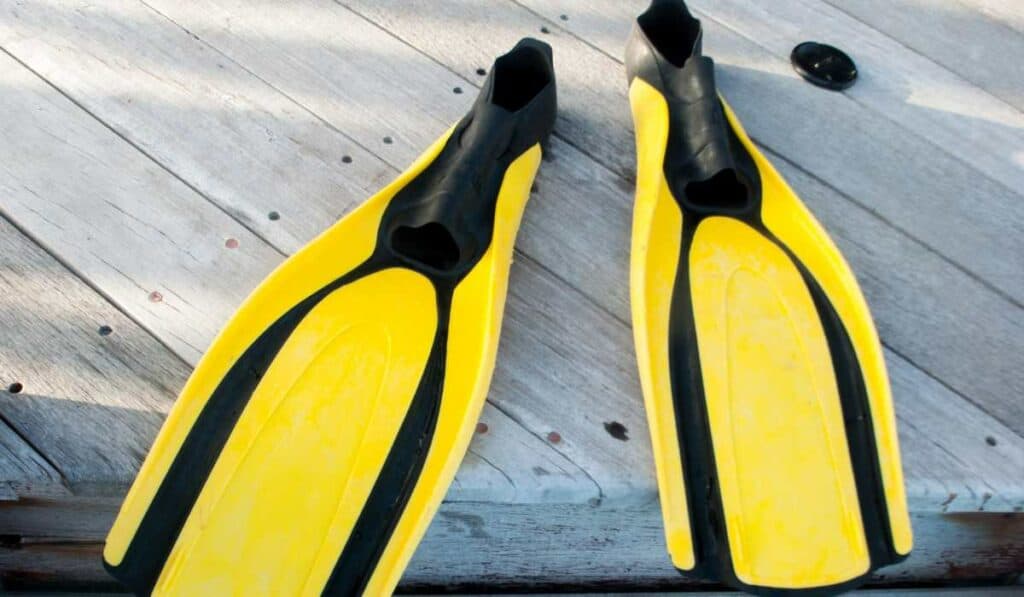
When shopping for scuba diving fins, it’s essential to consider various features that will affect your underwater experience. By understanding these factors, you can make an informed decision and choose the perfect fins for your needs.
Size & Fit
The right size and fit are crucial when selecting scuba diving fins. Ill-fitting fins can cause discomfort or even result in blisters during prolonged use. To ensure a proper fit, measure your foot size accurately and consult the manufacturer’s sizing chart before making a purchase. Additionally, try different styles with your dive booties, as some models may have specific requirements regarding footwear compatibility.
Material & Construction
Fins come in various materials such as rubber, plastic, or composite blends like carbon fiber and fiberglass. Each material has its pros and cons concerning durability, flexibility, and performance underwater resistance:
- Rubber: Offers excellent durability but tends to be heavier than other materials.
- Plastic: Lightweight yet less durable compared to rubber or composites.
- Composite Blends (Carbon Fiber/Fiberglass): Provide an optimal balance between weight reduction and strength while maintaining good flexibility for efficient propulsion underwater.
Diving Style & Performance Needs
Your preferred type of diving should play a significant role in determining which fin style is best suited for you. For example:
- Recreational Diving: Look for fins with a moderate level of stiffness and flexibility, providing efficient propulsion without causing fatigue.
- Tech or Cave Diving: Opt for stiffer fins that offer more power and control in tight spaces or strong currents. These may include specialized features like spring straps or heel bungees.
- Freediving/Spearfishing: Long-blade fins are ideal as they allow for maximum efficiency and speed while conserving energy during breath-hold dives.
Budget & Price Range
Last but not least, consider your budget when shopping for scuba diving fins. While it’s essential to invest in quality gear, you don’t necessarily need the most expensive model on the market. There are plenty of affordable options available that still provide excellent performance underwater – just be sure to read reviews from fellow divers before making your final decision.
In summary, by considering factors such as size, material construction, diving style preferences, and budget constraints, you can find the perfect pair of scuba diving fins tailored to your needs. Happy exploring.
When it comes to scuba diving fins, there are a variety of features that should be taken into consideration in order to find the best fit for you. Now let’s explore some of the top-rated scuba diving fins available.
Key Takeaway:
When buying scuba diving fins, it’s important to consider factors such as size and fit, material construction, diving style preferences, and budget constraints. Rubber fins are durable but heavy while composite blends offer a balance between weight reduction and strength. Different styles of fins suit different types of diving from recreational to tech or cave diving.
4. Top Rated Scuba Diving Fins
Dive into the underwater world with confidence and style by choosing from our list of top-rated scuba diving fins for 2023. We’ve researched and compared various models to bring you a selection that caters to different types of diverse, preferences, and budgets.
Aqua Lung Stratos ADJ
The Aqua Lung Stratos ADJ is an excellent choice for recreational divers seeking comfort and efficiency in their fin kicks. With its adjustable heel strap, dual-material construction, and anti-slip rubber pads on the foot pocket’s bottom, these fins provide optimal performance without sacrificing comfort. The unique blade design also helps reduce fatigue during long dives.
- Pros: Comfortable fit; efficient kicking; suitable for beginners or experienced divers.
- Cons: May be too flexible for some technical divers; not ideal for strong currents.
Mares Avanti Quattro Plus
If you’re looking for power combined with maneuverability, look no further than the Mares Avanti Quattro Plus. These fins feature four channels on each blade that maximize thrust while minimizing effort. They are perfect for both open water diving as well as cave or wreck exploration due to their responsive nature in tight spaces.
- Pros: Powerful propulsion; great maneuverability; durable materials used in construction.
- Cons: Can be heavy; may require some adjustment to your kicking style.
Scubapro Seawing Nova
The Scubapro Seawing Nova fins are known for their innovative design, which combines the power of a paddle fin with the flexibility and efficiency of a split fin. These fins have an articulated joint that allows them to pivot more naturally, reducing drag and improving propulsion. They’re suitable for all types of diving conditions and environments.
- Pros: Unique design offers excellent performance; versatile in various diving situations; comfortable foot pocket.
- Cons: Expensive compared to other options on this list; may take time to get used to its unique feel.
Click here to read about Best Spots for Scuba Diving in the Caribbean
Cressi Frog Plus EBS Fins
If you’re after an affordable yet reliable option, consider the Cressi Frog Plus EBS Fins. With their patented three-material injection molding process, these fins offer great durability without sacrificing comfort or performance. The adjustable bungee strap system ensures a secure fit while making it easy to put on and remove the fins quickly.
- Pros: Affordable price point; durable construction; easy-to-use bungee strap system.
- Cons: May not provide as much power as higher-end models listed here; suitable primarily for recreational divers rather than technical divers or those facing strong currents regularly.
For experienced and novice divers alike, the right scuba diving fins can make a world of difference. Selecting the ideal scuba fins for your requirements is essential to guarantee that your dive is both pleasant and comfortable.
Key Takeaway:
Looking for the best scuba diving fins in 2023? Look no further than our top-rated list, which includes options from Aqua Lung, Mares, Scubapro, and Cressi. Whether you’re a novice or an advanced diver, our top-rated selection of fins from Aqua Lung, Mares, Scubapro, and Cressi has something for everyone.
5. How to Choose the Right Scuba Diving Fins
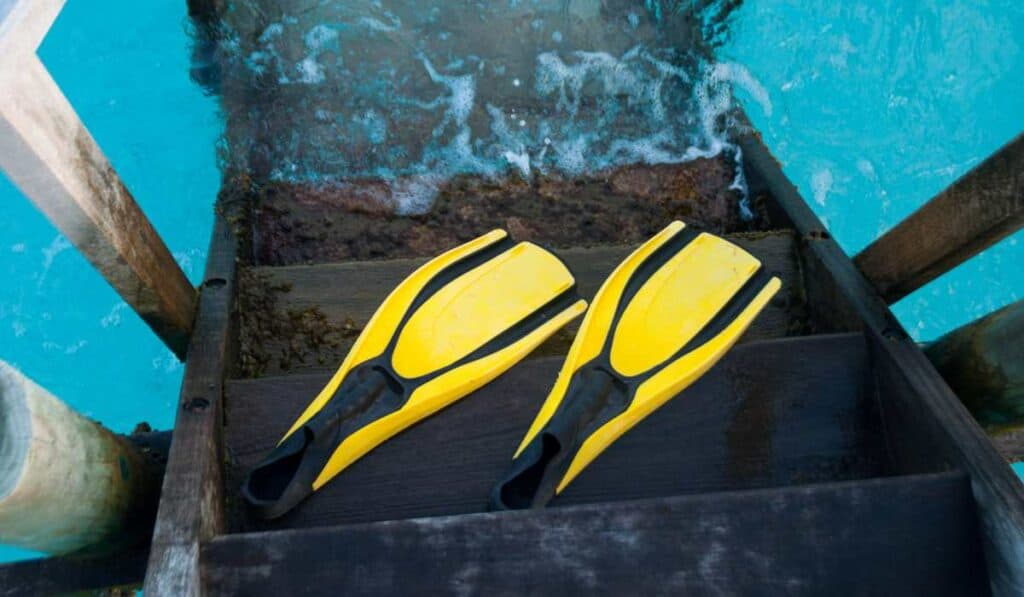
Selecting the appropriate scuba diving fins for your requirements and budget can be a challenging endeavor, with numerous choices available in the market. To make this process easier, we’ve compiled a list of factors you should consider when selecting your perfect pair of fins.
A. Determine Your Dive Type
The type of diving you plan to do will significantly impact your choice of fins. For example, if you’re into recreational diving, a more flexible fin might suit your needs better than one designed for technical or deep dives that require stiffer blades for propulsion efficiency.
B. Consider Your Skill Level and Experience
Your skill level plays an essential role in choosing the right scuba diving fins as well. Beginners may benefit from full-footed or split-fin designs that offer ease of use and maneuverability, while experienced divers may prefer open-heel or paddle-style fins that provide greater power and control during challenging dives.
C. Assess Comfort & Fit
- Foot pocket: Ensure that the foot pocket fits snugly without being too tight or causing discomfort over time.
- Strap system: Look for adjustable straps with quick-release buckles to ensure secure fitment throughout your dive session.
- Sizing: Consult sizing charts provided by manufacturers before making any purchase decisions – remember that sizes may vary between brands.
D. Evaluate Material & Durability
Fins are typically made from rubber, plastic, or a combination of both materials. Rubber fins tend to be more durable and flexible, while plastic fins are generally lighter and less expensive. It’s essential to consider the trade-offs between durability, weight, and cost when selecting your scuba diving fins.
E. Set Your Budget
Fins for scuba diving vary in cost, with basic models starting at approximately $30 and more advanced versions going up to hundreds of dollars. Determine your financial limits prior to beginning your search – this will aid in significantly reducing the range of possibilities.
F. Read Reviews & Seek Recommendations
Before making any purchase decisions, it’s always wise to read reviews from fellow divers who have tried out various fin models firsthand. Additionally, seek recommendations from friends or instructors at local dive shops – their experience can provide valuable insights into which scuba diving fins might work best for you.
Taking these factors into account will help ensure that you choose the right pair of scuba diving fins tailored specifically to your needs and preferences. Happy exploring.
Choosing the right scuba diving fins is essential for enjoying a safe and comfortable dive. Caring for your fins correctly can help them last longer.
Key Takeaway:
To choose the right scuba diving fins, consider your dive type, skill level and experience, comfort, and fit, material and durability as well as budget. Reading reviews from fellow divers who have tried out various fin models firsthand can also provide valuable insights into which scuba diving fins might work best for you. Remember to consult sizing charts provided by manufacturers before making any purchase decisions.
Click here to read about 7 Best Places for Scuba Diving in the USA
6. Care & Maintenance Tips for Scuba Diving Fins
Proper care and maintenance of your scuba diving fins are essential to ensure their longevity and optimal performance during underwater adventures. Here are some useful tips to help you keep your fins in top condition:
A. Rinse Thoroughly After Each Dive
Post-dive, give your fins a rinse with fresh H2O to get rid of any salt, sand or other particles that may have gathered while diving. This will prevent corrosion and damage caused by saltwater exposure over time. You can use a garden hose or a dedicated gear rinse station at the dive site for this purpose.
B. Dry Properly Before Storage
Drying your fins properly before storing them is crucial in preventing mold growth and unpleasant odors from developing within the fin pockets or straps. Make sure they are completely dry by hanging them up in a well-ventilated area away from direct sunlight, which could cause discoloration or warping of the material.
C. Store Flat or Hang Vertically
- Flat storage: If possible, store your scuba diving fins flat on a shelf or inside their carrying case when not in use.
- Hanging vertically: Alternatively, hang them vertically using specially designed fin hangers available online or at local dive shops – this helps maintain their shape over time.
D. Inspect Regularly for Damage
Prioritize inspecting your scuba diving fins regularly for any signs of wear or damage, such as cracks, tears, or loose straps. Address any issues promptly to prevent further deterioration and ensure your safety during dives.
E. Avoid Exposure to Extreme Temperatures
Keep your fins away from extreme heat sources like car trunks on hot days or direct sunlight for extended periods – this can cause the material to warp and lose its structural integrity. Similarly, avoid storing them in extremely cold environments that could make the fin material brittle and prone to cracking.
F. Lubricate Strap Buckles & Adjusters
If your scuba diving fins have adjustable strap buckles, lubricate them occasionally with a silicone-based lubricant designed for dive gear maintenance. This will help keep the buckles functioning smoothly and reduce friction-related wear over time.
By following these care and maintenance tips for your scuba fins, you’ll be able to enjoy many exciting underwater adventures while ensuring optimal performance from your gear.
Proper care and maintenance of your scuba diving fins is essential to ensuring their longevity. Moving on, the next heading will explore the cost of different types of scuba diving fins available in 2023.
Key Takeaway:
To ensure the longevity and optimal performance of your scuba diving fins, it’s important to rinse them thoroughly after each dive, dry them properly before storage, store them flat, or hang them vertically using specially designed fin hangers. Regularly inspect for damage and avoid exposure to extreme temperatures while lubricating strap buckles & adjusters occasionally with a silicone-based lubricant. By following these tips, you’ll be able to enjoy many exciting underwater adventures while ensuring optimal performance from your gear.
7. Cost of Scuba Diving Fins
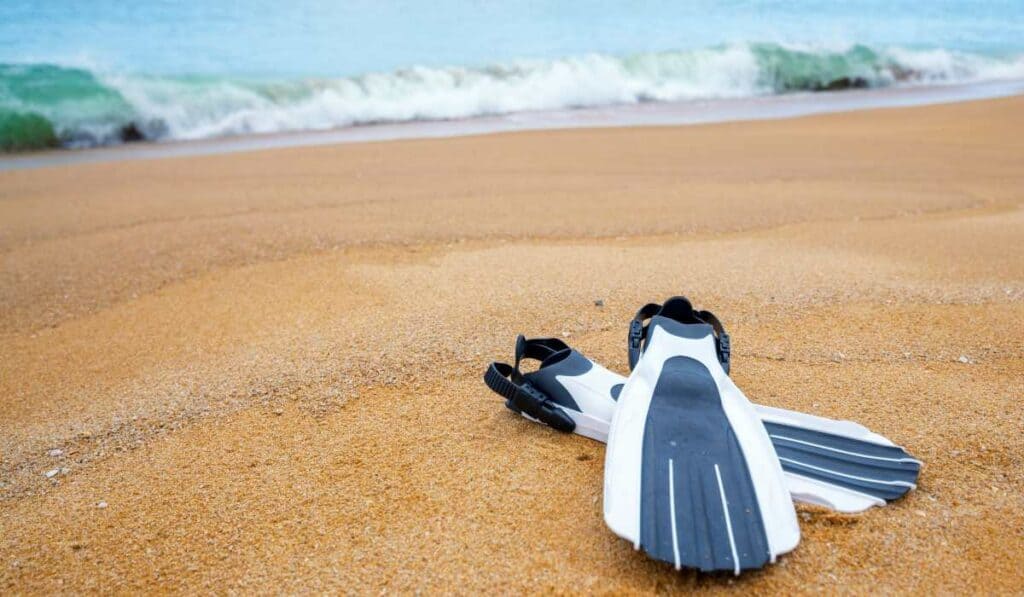
The cost of scuba diving fins can be substantially different, depending on the kind, material, and make you pick. In 2023, one can anticipate spending an amount on a pair of dependable scuba diving fins depending on the quality.
Affordable Options
If you’re a novice scuba diver or simply looking to save some cash, there are plenty of reasonably priced yet dependable fins accessible. You can find entry-level full-foot or open-heel fins ranging from $30 to $80. These models may not have all the advanced features found in higher-end models but still offer decent performance and comfort for recreational divers.
Mid-range Options
For those seeking a balance between affordability and performance, mid-range scuba diving fins typically cost between $80 and $150. These models often incorporate more advanced materials like thermoplastic rubber (TPR) or polypropylene that improve efficiency while maintaining flexibility and durability. Many popular brands such as Scubapro, Aqua Lung, and Mares offer excellent mid-range options suitable for various types of dives.
Premium Options
If you’re an experienced diver who wants top-of-the-line equipment with maximum power output, premium scuba diving fins might be your best choice. High-quality split fins or specialized technical dive fin designs fall into this category with prices ranging from $150 to over $300+. Premium brands like Atomic Aquatics and Hollis are known for their innovative designs, superior materials, and exceptional performance.
Customizable Options
In addition to the standard options mentioned above, some manufacturers offer customizable scuba diving fins that allow you to choose your preferred blade stiffness or color. Customizable models usually cost more but may be worth it for divers looking for a personalized fit. For example, Frogkick’s DK Fins start at around $250 with various customization choices available.
To find the best scuba fins within your budget in 2023, make sure to compare different brands and models while considering factors such as comfort, efficiency, durability, and style. Remember that investing in quality equipment is essential for an enjoyable underwater experience.
Key Takeaway:
In 2023, scuba diving fins can range from budget-friendly to expensive, with prices ranging from $30 up to over $300 for premium models. Premium fins for scuba diving that offer remarkable performance may be priced at over three hundred dollars, a great option for the experienced diver in search of top-notch gear.
FAQs about The Best Scuba Diving Fins
WHAT KIND OF FIN IS BEST FOR SCUBA DIVING?
The best fins for scuba diving are open-heel fins with adjustable straps, as they provide a secure fit and better propulsion. Split fins or paddle fins are popular choices due to their efficiency and ease of use. The choice depends on your personal preference, skill level, and the type of diving you plan to do
What is the Best Budget Scuba Diving Fin?
The Cressi Palau Long Adjustable Fins offer excellent performance at an affordable price. These open-heel adjustable strap fins have a comfortable foot pocket and deliver efficient propulsion suitable for beginners to advanced divers alike. Check out Cressi’s official website for more information about these budget-friendly options.
What are the Best Fins for Frog Kicking?
The Scubapro Jet Sport Fins are ideal for frog kicking due to their vented blade design that reduces drag while providing powerful thrusts during each kick cycle. This versatile fin style caters well to different kicking techniques, including frog kicks, making them suitable for various underwater environments. Visit Scubapro’s product page for further details.
What Kind of Fin Will You Be Buying for Scuba Diving and Why?
I would choose the Mares Avanti Quattro Plus Fins because they combine comfort, power, and maneuverability in one package. Their four-channel design ensures maximum thrust without exerting too much effort while maintaining precise control over movements underwatera€” a perfect balance between performance and ease of use needed by most divers. Find out more information on Mares’ official website.
Conclusion
Choosing the best scuba diving fins is crucial for a comfortable and enjoyable underwater experience. Various kinds of fins are accessible, each offering its own advantages and components to mull over prior to buying. By taking the time to research and compare options, divers can find the perfect pair of fins that suit their needs.
In this article, we’ve covered everything from the types of scuba diving fins to maintenance tips and cost considerations. We’ve also highlighted some top-rated options on the market in 2023. Whether you’re an experienced diver or a novice, having quality scuba diving fins can really boost your underwater experience.

